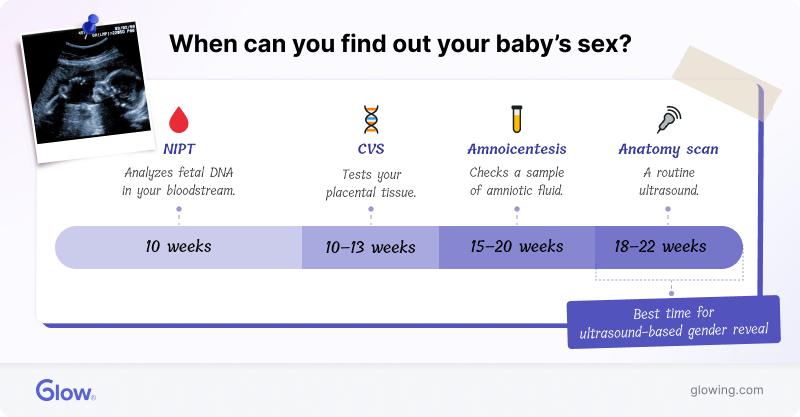How to Find Out Your Baby’s Gender with an Ultrasound
Of all the milestones you’ll hit throughout your pregnancy, finding out your baby’s sex is often one of the most exciting. Unless you’ve decided to keep it a surprise until birth, you probably can’t wait.

With ultrasound technology, you can get an early glimpse at whether you’ll welcome a boy or a girl—but how does an anatomy scan actually work, and how accurate is it?
Here’s all you need to know about your baby’s gender scan.
What is an anatomy scan?
An anatomy scan is a routine ultrasound that most pregnant women get during the second trimester. You may have also heard people call the procedure a “gender ultrasound,” although this is a non-standard term and not how your doctor will probably refer to it.
An ultrasound uses sound waves to create images of your developing baby. These waves, which are emitted from a wand-like device called a transducer, bounce off your baby’s body—his tissues, fluids, and bones—to generate a picture, which you can see on a screen. 1
Again, you’ll usually have the anatomy scan performed during your second trimester. During it, the ultrasound technician (sonographer) will look at: 2
- Your baby’s size and measurements
- The development of his organs
- His heart rate
- The amount of amniotic fluid surrounding him
- Your placenta’s position
- Your baby’s sex organs
These scans primarily assess your baby’s health and development. 2 However, finding out his sex (if you wish!) is a fun side benefit.
What will the anatomy scan actually be like?
During the ultrasound, you’ll lie back on an exam table while the technician applies a gel to your abdomen. They’ll then gently move a transducer across your belly, emitting sound waves that create a sonogram image.
In some cases, particularly in early pregnancy, the sonographer may perform an ultrasound transvaginally to get a clearer picture of your baby’s development. 3
To prepare for the scan, your doctor may ask you to drink plenty of water beforehand and arrive with a full bladder. This helps get a clearer ultrasound image and make it easier for the sonographer to capture accurate details.
When can you determine gender via ultrasound?
The ideal time for accurately assessing your baby’s gender on an ultrasound is when you’re between 18 weeks and 22 weeks pregnant. 4
Before this, your baby’s sex organs are still in the early stages of development, which makes resolving them difficult.
Is the gender scan always accurate?
Pregnancy ultrasounds are highly accurate, particularly during the second trimester, but it’s still possible you won’t get a clear answer, at least the first time. Sometimes, babies don’t cooperate and are positioned in a way that obscures the genital area (e.g., legs crossed); if so, you’ll just have to wait to find out your baby’s sex.
Several other factors can also make it harder to gauge:
- Bloating: Gas and bloating during pregnancy can create shadows or cloud the image.
- Body size: If you have a larger body, that can sometimes make it harder to get a clear picture, too.
- Multiples: If you’re expecting twins or more, determining each baby’s sex will be more difficult as they may move or obscure each other.
How will the sonographer determine your baby’s sex?
During the ultrasound, the sonographer will look for visual cues to determine whether you have a boy or a girl. Early on in development, all babies have similar-looking genitalia, but subtle differences emerge over time that allow for gender identification during your anatomy scan.
Signs of a baby boy
- The “turtle sign”: This sign refers to the tip of the penis peeking out from behind the testicles. 5
- The dome shape: When viewed from below, a dome-like shape between the legs may indicate the presence of a penis and scrotum. 6
- The sagittal sign: If the caudal notch, a small nub at the end of the spine, points upward, your baby is more likely a boy. 6
Signs of a baby girl

Other ways to determine your baby’s sex
If you’re looking for earlier or more definitive results, there are other options to consider:
- Non-invasive prenatal testing (NIPT): This blood test analyzes fetal DNA in your bloodstream. You can usually take it from 10 weeks onward. 8
- Chorionic villus sampling (CVS): You can get this genetic test between week 10 and week 13 of your pregnancy. It’s primarily used to detect chromosomal abnormalities, but it can also reveal your baby’s sex. 9
- Amniocentesis: Your doctor may perform this test between week 15 and week 20 of your pregnancy by extracting your amniotic fluid for genetic analysis. These results can also tell you whether your baby is a boy or a girl. 10
Your pregnancy symptoms or placenta can’t tell you the sex of your baby
Many people believe that certain pregnancy symptoms indicate the sex of your baby (e.g., if you have stronger morning sickness, you’re having a girl). Others say that which side your placenta grows on corresponds to the sex (this is known as the Ramzi theory). Unfortunately, there’s almost no scientific evidence for these ideas. You almost certainly won’t be able to use any of them to predict your baby’s gender.
What is the nub theory, and is it reliable?
According to the nub theory, the angle of the genital tubercle—a small bud that develops into the genitalia—can reveal your baby’s sex as early as 12 weeks. 11
Allegedly, if you’ve got a boy, the genital tubercle is angled upward from the spine. If you’re having a girl, the genital tubercle is angled downward, parallel to the spine. 12
While it’s fun to speculate and look for signs of having a boy or a girl early on, this test isn’t as reliable as the anatomy scan. You’ll almost certainly be able to learn your baby’s gender around the 18 to 22-week mark, so just try to be patient.
What is the Chinese gender predictor chart, and does it work?
If you’re finding it hard to wait and are looking for other options, you may have heard that the Chinese gender predictor chart can tell you your baby’s sex much earlier than an ultrasound.
It works by calculating your baby’s sex based on your lunar age when you conceived and the month of conception.
However, there’s no evidence that the Chinese gender predictor chart can accurately predict your baby’s sex—it’s based on folklore, not scientific research. Still, it’s a harmless way to have fun while you wait to learn whether you’re having a boy or a girl for real, and there’s a 50% chance that it’ll be right!
Final thoughts
Again, while gender predictions are generally accurate during an ultrasound scan, they aren’t always 100% foolproof. Your baby’s position, your body, and good old-fashioned human error may all cause you to get a false reading.
But whether you choose to find out your baby’s sex during the anatomy scan or prefer to play the guessing game a little longer, your baby’s anatomy scan will give you the peace of mind that your little one is developing just as he should.
Article Sources
- MedlinePlus. "Ultrasound pregnancy" Retrieved April 16, 2025.
- University of Rochester Medical Center. "Common Tests During Pregnancy" Retrieved April 16, 2025.
- MedlinePlus. "Transvaginal ultrasound" Retrieved April 16, 2025.
- National Health Service. "20-week screening scan" Retrieved April 16, 2025.
- The Birth Company. "Home" Retrieved April 16, 2025.
- Australasian Journal of Ultrasound in Medicine. "A pictorial guide for the second trimester ultrasound" Retrieved April 16, 2025.
- StatPearls. "Sonography 2nd Trimester Assessment, Protocols, and Interpretation" Retrieved April 16, 2025.
- MedlinePlus. "What is noninvasive prenatal testing (NIPT) and what disorders can it screen for?" Retrieved April 16, 2025.
- MedlinePlus. "Chorionic Villus Sampling (CVS)" Retrieved April 16, 2025.
- MedlinePlus. "Amniocentesis (amniotic fluid test)" Retrieved April 16, 2025.
- The University of Texas Southwestern Medical Center. "Boy or girl? The difficulties of early gender prediction" Retrieved April 16, 2025.
- Nigerian Medical Journal. "The accuracy of 2D ultrasound prenatal sex determination" Retrieved April 16, 2025.







